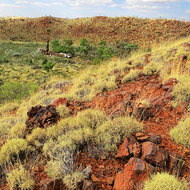The findings from a drilling project in the Pilbara were recently presented at a Geoscience Research workshop.
| Date: | Tuesday, 07 November 2017 |
|---|
The findings from a scientific drilling project between the Department of Mines, Industry Regulation and Safety (DMIRS) and Atlas Iron Ltd were presented at an international geology workshop in Perth’s CBD.
The ‘Shock Metamorphism in Terrestrial and Extra-terrestrial Rocks’ event was held at the Old Perth Boys School on St George’s Terrace and was hosted by the Institute for Geoscience Research at Curtin University.
DMIRS’ Senior Petroleum Geologist, Peter Haines of the Geological Survey Western Australia (GSWA) said it was a real privilege to be invited to present the department’s findings from the 2012 Hickman Crater drilling project.
“Named in honour of GSWA geologist Dr Arthur Hickman following his initial discovery of the site in 2007 using Google Earth, the 260 metre diameter Hickman Crater is situated in the Hamersley Range in the Pilbara and is thought to be between 100,000 and 10,000 years old. GSWA was interested to confirm early suspicions that the newly discovered Hickman Crater was a meteorite impact crater and in 2012, GSWA ran a drilling project in collaboration with Atlas Iron Ltd, who were doing some work in the area at the time,” he explained.
“The 65 metre deep drillhole found that the centre of the crater is filled in by about 48 metres of sediment that was washed in after the crater formed. Below this is a nearly seven metre thick layer of finely smashed up and melted rock that formed the original crater floor, underlain by fractured bedrock. Chemical analysis of the smashed up and melted rock shows, besides comprising fragments of bedrock, it also contains traces of material from an iron meteorite. The internal structure of the crater is similar to that found at other small meteorite impact craters drilled overseas and confirms that the crater was produced by a meteorite impact.
“I received some really interesting feedback on my presentation in the networking sessions and even some suggestions about what else we could do with the data in the future,” said Dr Haines.
To understand more about the Hickman Crater and meteorite impacts in Western Australia, please visit the DMIRS website.

